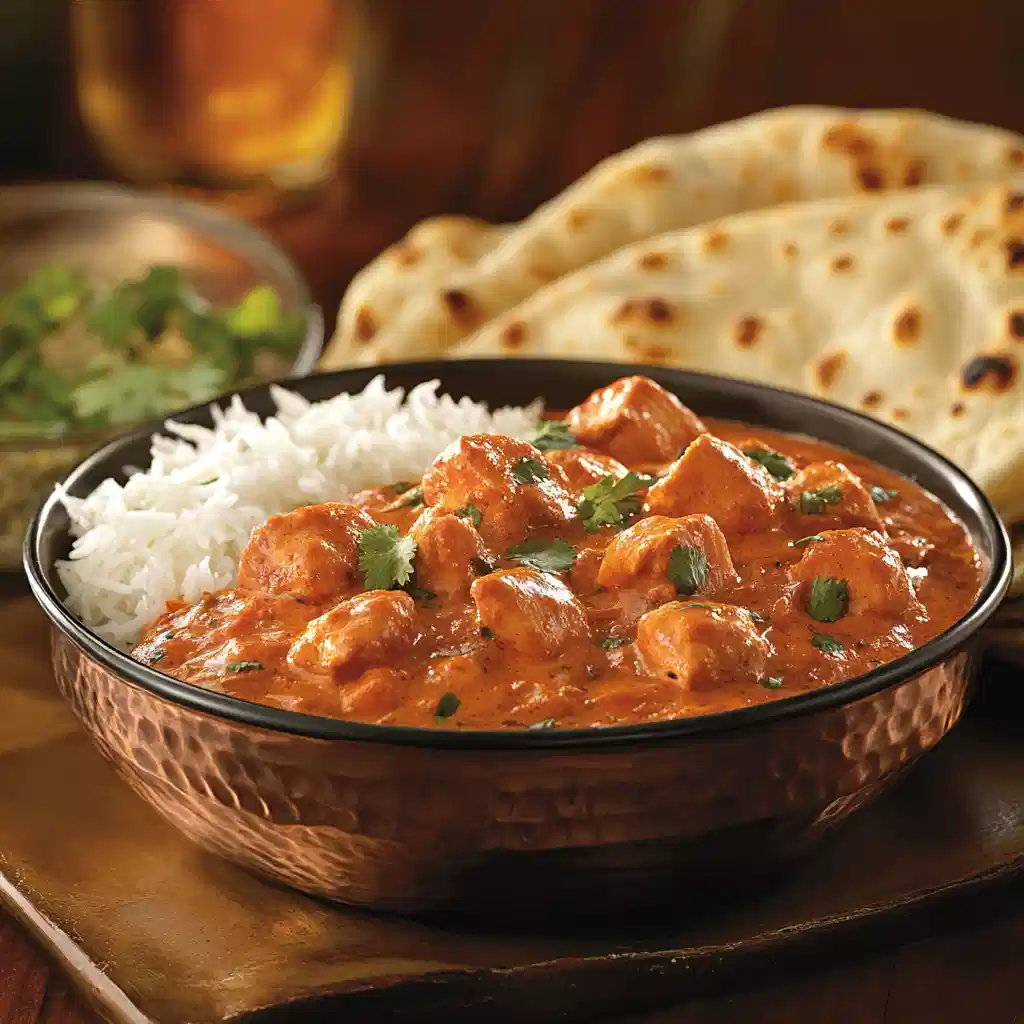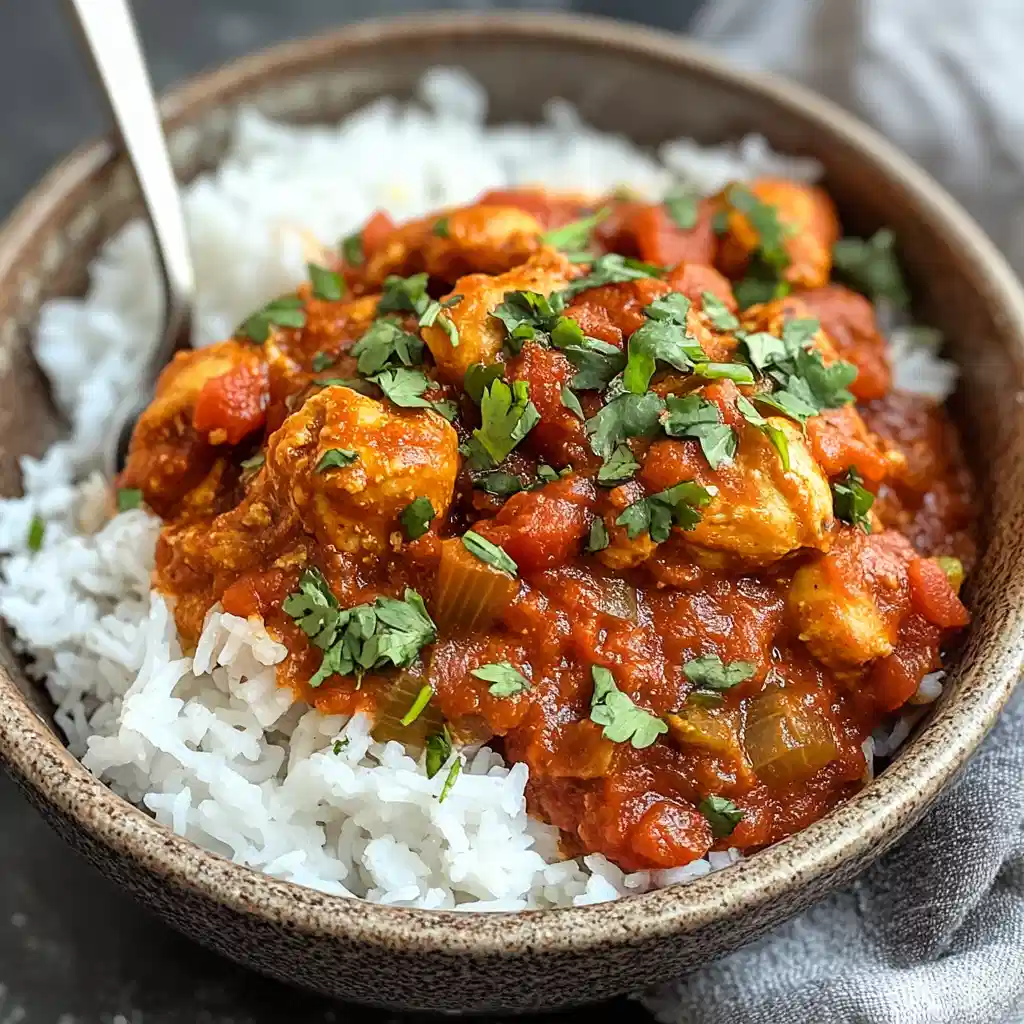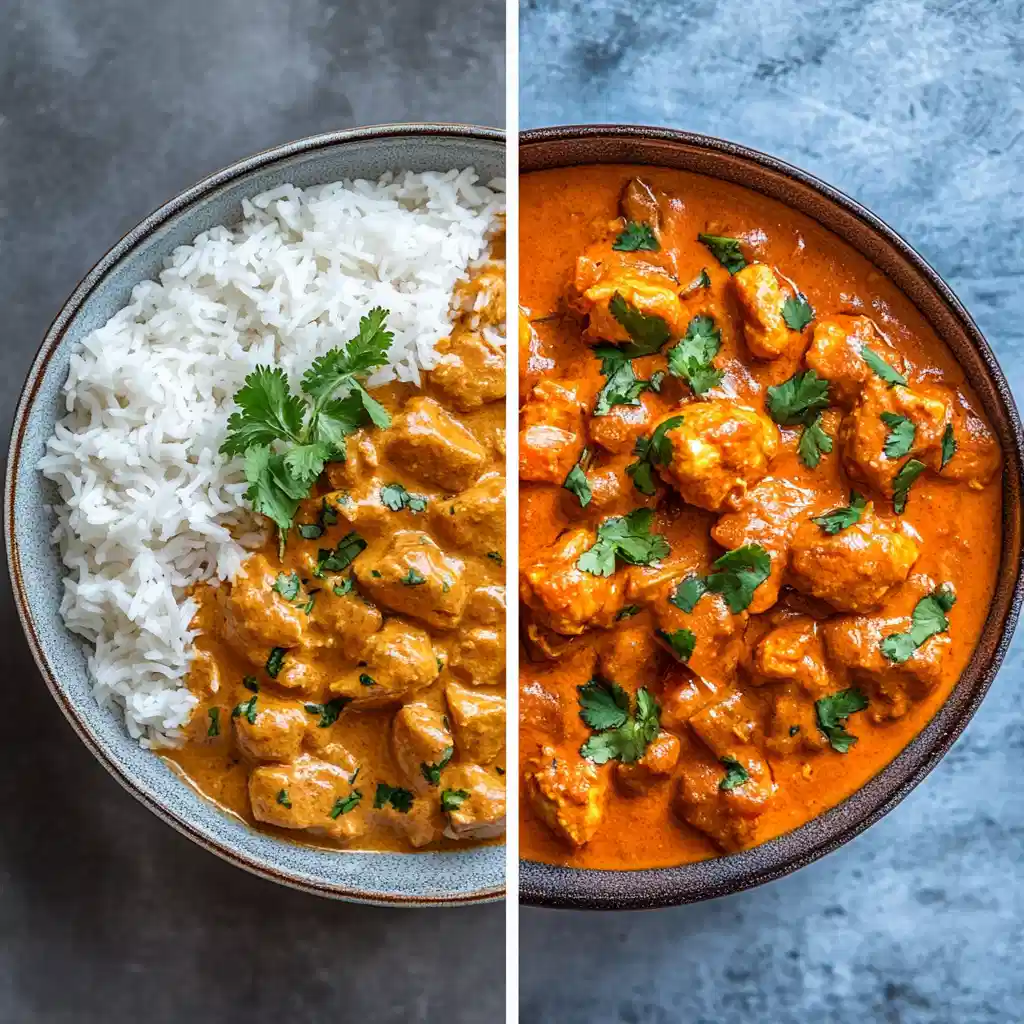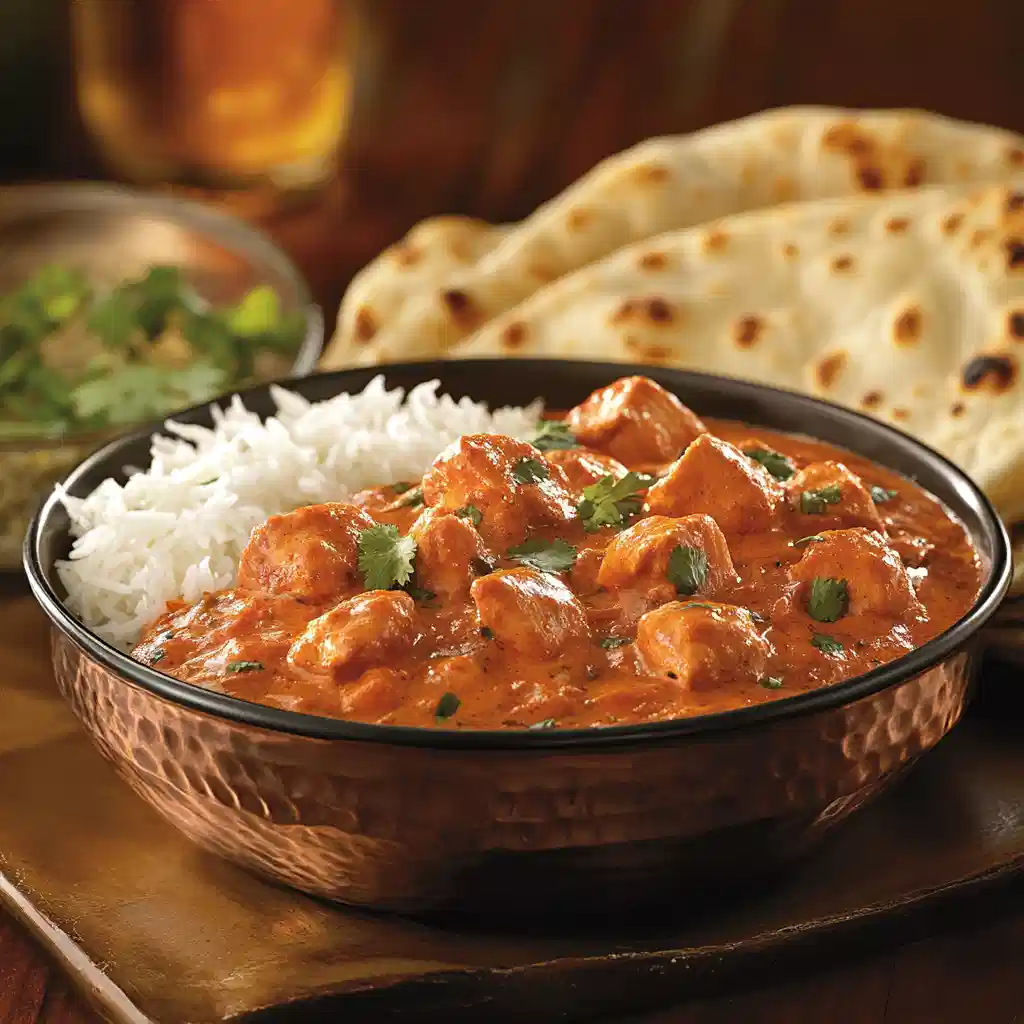Introduction
Chicken tikka masala Calories is one of the most popular Indian dishes worldwide, known for its flavorful, creamy tomato-based sauce and tender, marinated chicken pieces. Often served with rice or naan, it’s a meal that satisfies both the palate and the soul.
However, like many rich and indulgent dishes, chicken tikka masala can pack a significant amount of calories. Whether you’re enjoying it at a restaurant or preparing it at home, understanding the calorie content can help you make mindful choices.
In this article, we’ll break down the calories in chicken tikka masala, highlight factors that influence its nutritional value, and provide tips for creating a lighter version of this beloved dish.
Understanding the Calories in Chicken Tikka Masala
Typical Calorie Range
The calorie content in chicken tikka masala varies widely depending on the recipe and portion size. On average:
- One serving (1 cup or 8 oz): Contains approximately 250–400 calories without sides like rice or naan.
- Restaurant servings: Often larger and richer, with calorie counts ranging from 400–700 calories per serving.
Factors Affecting Calorie Content
Several factors influence the calorie count in chicken tikka masala:
- Type of Chicken:
- Chicken Breast: Lower in calories (150 calories per 3 oz).
- Chicken Thighs: Slightly higher in calories due to additional fat (180–200 calories per 3 oz).
- Sauce Ingredients:
- Tomato Base: A low-calorie foundation (15–20 calories per 1/2 cup of canned tomatoes).
- Cream or Yogurt:
- Full-fat cream can add 100–150 calories per serving.
- Low-fat yogurt offers a lighter alternative, contributing just 30–50 calories.
- Cooking Fats:
- Traditional recipes often use butter or ghee, adding 50–70 calories per tablespoon. Reducing or substituting these fats can significantly lower the calorie count.
By understanding these factors, you can tailor the recipe to fit your dietary preferences and goals.
Nutritional Breakdown

Calories from Chicken
The chicken in chicken tikka masala is typically marinated in a mixture of yogurt and spices before being grilled or cooked in the sauce. The calorie content largely depends on the cut of chicken used:
- Chicken Breast (Skinless, Boneless): ~150 calories per 3 oz serving.
- Chicken Thighs (Skinless): ~180–200 calories per 3 oz serving.
Using lean chicken breast is a great way to reduce calories while maintaining a high protein content.https://www.livestrong.com/article/375627-chicken-tikka-masala-nutrition-information/
Calories from the Sauce
The creamy, flavorful sauce is where the calories can quickly add up:
- Tomatoes and Spices: A base of pureed tomatoes with spices like turmeric, cumin, and garam masala contributes minimal calories (20–40 calories per serving).
- Cream or Yogurt:
- Heavy cream can add 100–150 calories per 1/4 cup.
- Low-fat yogurt is a lighter alternative, adding only 30–50 calories for the same quantity.
- Butter or Ghee: Often used for richness, it adds 50–70 calories per tablespoon.
Optional Ingredients
Some recipes include extra ingredients that can influence calorie content:
- Cashew Paste: Adds creaminess but can contribute 60–80 calories per tablespoon.
- Coconut Milk: A popular substitution for cream, with 45–60 calories per 1/4 cup of light coconut milk.
Total Calories Without Sides
- A typical homemade chicken tikka masala with lean chicken, low-fat yogurt, and minimal butter is approximately 250–300 calories per cup.
- A restaurant-style chicken tikka masala, made with cream and ghee, can range from 400–700 calories per serving.
Understanding the breakdown helps you identify areas where you can make adjustments to create a lighter version without sacrificing flavor.
Calories in Restaurant vs. Homemade Chicken Tikka Masala
Restaurant Chicken Tikka Masala
When dining out, chicken tikka masala is often richer and higher in calories due to generous use of cream, butter, and larger portion sizes.
- Average Calories: 400–700 calories per serving.
- Why So High?
- Portion Sizes: Restaurants often serve larger portions, equivalent to 1.5–2 cups per serving.
- Ingredients: Heavy cream and butter are used liberally to enhance flavor and texture.
- Oil Content: Extra oil is often added to sauté spices and finish the dish.
Homemade Chicken Tikka Masala
Homemade versions offer more control over ingredients, allowing you to reduce calories without sacrificing flavor.
- Average Calories: 250–400 calories per serving.
- Why Healthier?
- Ingredient Control: Swap heavy cream for low-fat yogurt or light coconut milk.
- Reduced Fats: Use less butter or replace it with olive oil.
- Lean Protein: Opt for skinless chicken breast to cut down on fat and calories.
Key Differences
| Aspect | Restaurant | Homemade |
|---|---|---|
| Portion Size | Larger (1.5–2 cups) | Smaller (1 cup) |
| Cream and Butter | Heavy usage | Controlled or substituted |
| Calorie Range | 400–700 calories per serving | 250–400 calories per serving |
Homemade chicken tikka masala not only offers a healthier option but also lets you tailor the flavors to your preference, making it a win-win for taste and nutrition.https://royalesrecipes.com/how-many-calories-in-chicken-tikka-masala/
How to Make Low-Calorie Chicken Tikka Masala

Ingredient Substitutions
Simple swaps can significantly reduce the calorie content of chicken tikka masala without compromising flavor:
- Heavy Cream: Replace with low-fat Greek yogurt, light coconut milk, or unsweetened almond milk. These alternatives add creaminess with fewer calories.
- Butter or Ghee: Use a smaller amount or replace with olive oil for a lighter fat option.
- Chicken Thighs: Opt for skinless chicken breasts to cut fat and calories while maintaining high protein content.
Cooking Methods
Adjusting the cooking technique can also make a difference:
- Grill or Broil the Chicken: Instead of frying, grill or broil the marinated chicken for a charred flavor with less oil.
- Saute Spices with Minimal Oil: Toast spices in a non-stick pan with just a teaspoon of oil to enhance their aroma without excess calories.
- Skip the Cashews: If your recipe calls for cashew paste, omit it or use a smaller amount to reduce fat.
Portion Control
Serving smaller portions of chicken tikka masala alongside lighter sides can help manage calorie intake:
- Keep the Serving Size to 1 Cup: Pair it with steamed vegetables or a small portion of rice for a balanced meal.
- Focus on Sides: Add a simple cucumber salad or roasted cauliflower as a filling, low-calorie accompaniment.
Recipe Example: Low-Calorie Chicken Tikka Masala
Ingredients:
- 1 lb skinless, boneless chicken breast
- 1 cup plain low-fat yogurt (for marinade)
- 1 can (14 oz) crushed tomatoes
- 1/4 cup light coconut milk or almond milk
- 2 tsp olive oil
- Spices: 1 tsp turmeric, 1 tsp garam masala, 1 tsp cumin, 1 tsp paprika, 1/2 tsp cayenne (optional)
Instructions:
- Marinate the chicken in yogurt and spices for at least 30 minutes.
- Grill or broil the chicken until lightly charred.
- In a non-stick pan, sauté spices with olive oil and add crushed tomatoes. Simmer for 10 minutes.
- Stir in coconut milk or almond milk and cook until the sauce thickens slightly.
- Add the grilled chicken and simmer for 5 minutes.
Calories Per Serving (1 Cup): ~250 calories.
These adjustments make chicken tikka masala lighter without losing its signature richness and flavor.
Calories with Common Sides
Chicken tikka masala is often served with accompaniments that can significantly impact the overall calorie count of your meal. Here’s how popular sides contribute to the total:
Basmati Rice
A common pairing, basmati rice provides a neutral base that complements the rich flavors of chicken tikka masala.
- 1 Cup Cooked Basmati Rice: ~200 calories.
- To reduce calories, consider serving half a cup or substituting with cauliflower rice, which adds only 25–30 calories per cup.
Naan Bread
Naan bread adds a deliciously soft and chewy texture, perfect for scooping up sauce. However, it’s calorie-dense:
- 1 Medium-Sized Naan: ~250–300 calories.
- For a lighter option, try whole-wheat naan (~200 calories) or skip it altogether and serve with a side salad.
Roti or Chapati
Roti or chapati is a lighter alternative to naan bread, made without butter or oil.
- 1 Small Roti (6-inch): ~100–120 calories.
- This can be a more calorie-conscious option while still adding variety to the meal.
Salad or Vegetables
Pairing chicken tikka masala with a salad or steamed vegetables not only balances the meal but also keeps the calorie count low.
- Simple Cucumber and Tomato Salad: ~50 calories per serving.
- Steamed Broccoli or Cauliflower: ~30–50 calories per cup.
Meal Total Example
Here’s an example of how calories can add up based on common pairings:
- 1 Cup Chicken Tikka Masala: ~300 calories.
- 1/2 Cup Basmati Rice: ~100 calories.
- 1 Small Roti: ~120 calories.
- Cucumber Salad: ~50 calories.
- Total: ~570 calories for a balanced, satisfying meal.
By choosing lighter sides or smaller portions, you can enjoy chicken tikka masala without exceeding your calorie goals.
FAQs
How many calories are in chicken tikka masala?
The calorie content of chicken tikka masala can vary:
- Homemade Version: ~250–400 calories per serving (1 cup).
- Restaurant Version: ~400–700 calories per serving, depending on portion size and ingredients like heavy cream and butter.
Can I make chicken tikka masala healthier?
Yes, by making simple adjustments:
- Use low-fat yogurt or light coconut milk instead of heavy cream.
- Opt for skinless chicken breast instead of thighs.
- Reduce the amount of butter or ghee in the recipe.
- Pair with low-calorie sides like cauliflower rice or steamed vegetables.
How does chicken tikka masala compare to other Indian dishes in calories?

Chicken tikka masala is moderately calorie-dense. Here’s how it compares:
- Butter Chicken: Similar calorie range but often higher due to additional cream and butter (~300–500 calories per cup).
- Vegetable Curry: Typically lower, around 200–300 calories per cup, depending on the ingredients.
- Paneer Tikka Masala: Higher in calories (~400–600 per cup) due to the paneer (Indian cheese).
Is chicken tikka masala high in protein?
Yes, chicken tikka masala is a good source of protein:
- Chicken Breast Version: ~30 grams of protein per cup.
- Chicken Thigh Version: ~25 grams of protein per cup.
Does chicken tikka masala have carbs?
The sauce contains some carbs from tomatoes and spices:
- Carbs in the Sauce: ~10–15 grams per serving.
- Carbs with Sides: Adding rice or naan can significantly increase the carb count.
Is chicken tikka masala keto-friendly?
Traditional chicken tikka masala can be adapted for a keto diet by:
- Omitting high-carb sides like rice and naan.
- Using full-fat yogurt or heavy cream for the sauce.
- Ensuring the dish contains no added sugar or flour.
Heading 2: Conclusion
Chicken tikka masala is a flavorful and satisfying dish that can fit into a variety of dietary lifestyles when enjoyed mindfully. With its creamy tomato-based sauce and tender marinated chicken, it’s no wonder this dish has become a global favorite. However, understanding its calorie content is essential for balancing indulgence with health goals.
By making small adjustments—such as swapping heavy cream for low-fat yogurt, using lean chicken breast, and pairing it with lighter sides like cauliflower rice or salad—you can significantly reduce the calorie count without sacrificing flavor. Whether dining out or preparing it at home, chicken tikka masala can be part of a healthy and enjoyable meal plan.
So, embrace this iconic dish, savor its rich flavors, and make it work for your lifestyle. With these tips, you can enjoy chicken tikka masala guilt-free and delight in every bite!

